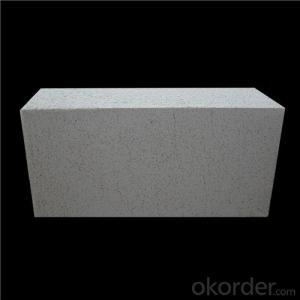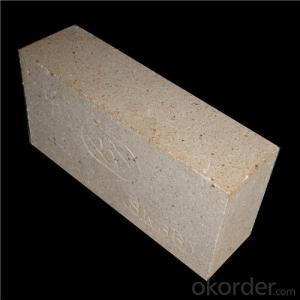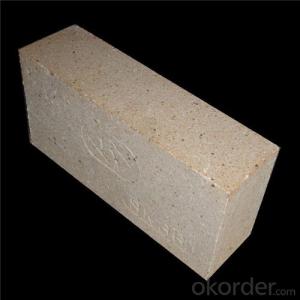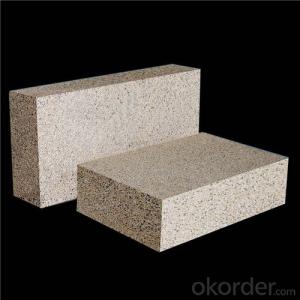Refractory High Alumina Thermal Insulating Fire Brick 2015
- Loading Port:
- Tianjin
- Payment Terms:
- TT or LC
- Min Order Qty:
- 10 m.t.
- Supply Capability:
- 1000 m.t./month
OKorder Service Pledge
OKorder Financial Service
You Might Also Like
Quick Details for Refractory High Alumina Thermal Insulating Fire Brick 2015
| Place of Origin: | China (Mainland) | Shape: | Brick | Material: | Alumina Block |
| SiO2 Content (%): | international index | Al2O3 Content (%): | ≥48 | MgO Content (%): | 0 |
| CaO Content (%): | 0 | Refractoriness (Degree): | Common (1580°< Refractoriness< 1770°) | CrO Content (%): | 0 |
| SiC Content (%): | 0 | Model Number: | LG-1.0 | Brand Name: | |
| Sample: | Free | Fe2O3 %: | ≤2 | Bulk Density, g/cm3: | ≤1.0 g/cm3 |
| Cold crushing strength(Mpa): | ≥3.9 | temp linear change on reheating: | 1400 | Thermal conductivity /W.(m.k)-1: | ≤0.5 |
| size: | 230mm*114mm*65/75mm | HS code: | 6902200 |
Packaging & Delivery
| Packaging Details: | Packed on wooden pallets, with water-proof cover, all measurements of each case is 1050mm*1050mm*1050mm. We will pack the goods according to your requirement. |
| Delivery Detail: | 10~30 days after receiving your payment |
refractory lightweight high alumina thermal insulating fire brick
Product Description
Refractory lightweight high alumina thermal insulating fire brick is made out of a naturally-occurring material known as bauxite. This material includes aluminum hydroxide, which is what gives the bricks such great warmth resistance. The bricks also include kaolinitic clays, which are roasted to create an unique combination including mullite and also synthetic alumina. This is where the name “high alumina” stems from.
Features
1.High-temperature endurable .
2.Good thermal shock resistance .
3.High cold crushing strength.
4.Good resistance to abrasion and corrosion.
5.Good thermal spalling resistance.
6.High mechanical strength.
7.Good volume stability at high temperature.
Application
1.General use in heat containment unit form temperature 1500-2000°C.
2.Resistant to highest temperature for steelmaking operations such as ladle applications, sidewall, roofs, burner blocks, anchor brick for reheating furnaces and many other areas.
3.transition and cooling zones of rotary cement kilns, lime kilns , etc.
4.lower sidewall and bottom of aluminum refining,melting furnaces ,etc.
Technical Data
Description of parameters |
Index of high alumina lightweight fire brick | ||||||
LG- 1.0 | LG-0.9 | LG-0.8 | LG-0.7 | LG-0.6 | LG-0.5 | LG-0.4 | |
AL2O3 % | ≥48 | ||||||
Fe2O3 % | ≤2.0 | ||||||
Bulk Density, g/cm3 | ≤1.0 | ≤0.9 | ≤0.8 | ≤0.7 | ≤0.6 | ≤0.5 | ≤0.4 |
Cold Crushing Strength MPa | ≥3.9 | ≥3.4 | ≥2.9 | ≥2.5 | ≥2.0 | ≥1.5 | ≥0.8 |
Test temp linear change within 2%on reheating | 1400 | 1400 | 1400 | 1350 | 1350 | 1250 | 1250 |
Thermal conductivity /W.(m.k)-1 | ≤0.5 | ≤0.45 | ≤0.35 | ≤0.35 | ≤0.30 | ≤0.25 | ≤0.20 |
Packaging & Shipping
1. Strong packing will protect the goods from any possible damage during transit.
2. Solid packing and overall stuffing can prevent the cases from vibration and jarring.
3. We must take necessary precaution that the packing can protect the goods from pilferage or rain.
4. l can confirm that we take every possible precaution to ensure that our products reach our customers all over the world in prime conditon.
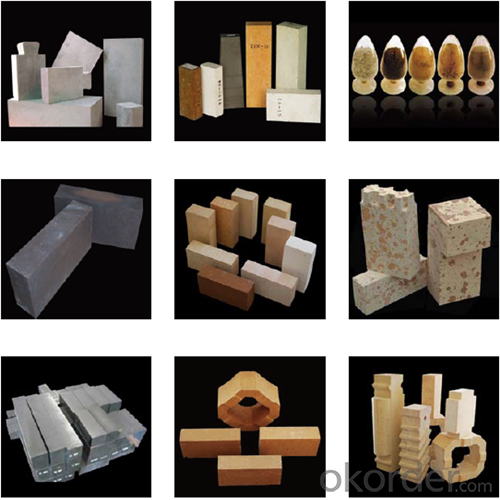
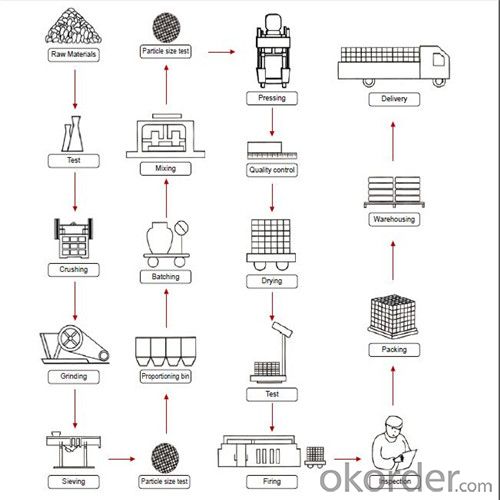
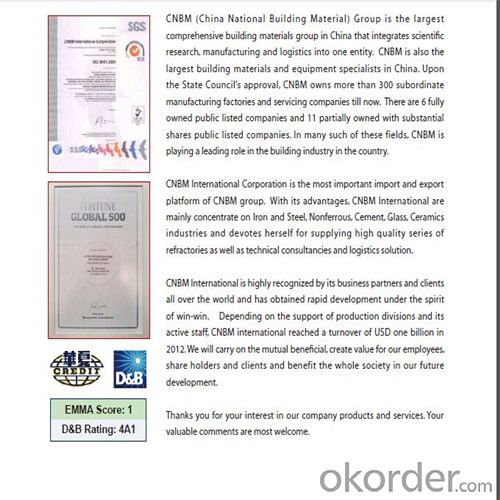
Our Services
1.We will reply to you immediately, if you have any question.
2.We can provide free samples for you.
3.we have all kinds of fire bricks ,for example,high alumina brick ,fireclay brick, corundum brick, refractory ball, allotypic brick, lightweight brick and so on. We can offer you products of a wide range of specifications.
Why choose us
1.We are professional manufacturer of refractory brick and had been in this line for more than 20 years .
2.Our products quality will be guaranteed . We have our own technical team to test the products before delivery.
3.Competitive prices based on same quality. Guarantee samples quality same as mass production quality.
4.Adhering to the business philosophy "mutual trust, mutual benefit, mutual profit, faith oriented".
5.We can according to your requirements to produce your order and OEM/ODM service is available.
6. Products are inspected through SGS and BV etc and accord with the international standard.
7.Your inquiry related to our products or prices will be replied in a timely manner.
8. We provide the best after sales service.
- Q:What is the typical thermal expansion coefficient of an insulating fire brick?
- The typical thermal expansion coefficient of an insulating fire brick can vary depending on the specific material composition and manufacturing process. However, in general, insulating fire bricks have a low thermal expansion coefficient compared to other types of bricks. The thermal expansion coefficient is a measure of how much a material expands or contracts when subjected to changes in temperature. Typically, the thermal expansion coefficient of an insulating fire brick ranges from 5 to 8 x 10^-6 per degree Celsius (5-8 μm/m°C). This means that for every degree Celsius increase in temperature, the insulating fire brick will expand by approximately 5 to 8 micrometers per meter of length. The low thermal expansion coefficient of insulating fire bricks is desirable in applications where temperature changes are frequent and significant. This property helps to minimize the risk of thermal stress and cracking, ensuring the longevity and performance of the insulating fire brick in high-temperature environments. It is important to note that the specific thermal expansion coefficient may vary based on the manufacturer, the type of insulating fire brick, and the temperature range in which it is intended to be used. Therefore, it is recommended to consult the manufacturer's specifications or technical data sheets for accurate and detailed information regarding the thermal expansion coefficient of a specific insulating fire brick.
- Q:Can insulating fire bricks be used in the construction of pizza ovens?
- Yes, insulating fire bricks can be used in the construction of pizza ovens. These bricks are designed to withstand high temperatures and provide excellent insulation, making them ideal for use in pizza ovens. They can help retain heat efficiently, resulting in a more even and consistent cooking temperature. Insulating fire bricks also have low thermal conductivity, which means they prevent heat loss and ensure the pizza oven remains hot for longer periods, enhancing energy efficiency. Overall, using insulating fire bricks in the construction of pizza ovens can contribute to better heat retention, improved cooking performance, and more energy-efficient operation.
- Q:How do insulating fire bricks affect the overall thermal stability of a structure?
- Insulating fire bricks enhance the overall thermal stability of a structure as they have low thermal conductivity, preventing heat transfer and minimizing energy loss. By acting as a barrier, these bricks help in maintaining a consistent temperature within the structure, reducing the impact of external temperature fluctuations. This enhanced thermal stability promotes energy efficiency, cost savings, and a more comfortable environment within the structure.
- Q:Can insulating fire bricks be used as a backup insulation in refractory linings?
- Yes, insulating fire bricks can be used as a backup insulation in refractory linings. Insulating fire bricks are designed to have low thermal conductivity, which makes them effective in reducing heat transfer in high-temperature applications. Their insulating properties make them ideal for use as a backup insulation layer in refractory linings, helping to further reduce heat loss and improve overall energy efficiency. Additionally, insulating fire bricks are lightweight, which makes them easier to handle and install compared to other refractory materials. However, it is important to consider the specific requirements of the application and consult with a refractory engineer to ensure that insulating fire bricks are suitable for the specific conditions and performance requirements of the refractory lining.
- Q:How do insulating fire bricks compare to other refractory materials?
- Insulating fire bricks (IFBs) are refractory materials specifically designed for thermal insulation in high-temperature environments. They offer several distinct advantages compared to other refractories. To begin with, IFBs have a lower density, making them lighter and easier to handle. This characteristic allows for quicker and more efficient installation, reducing labor costs and time. Moreover, IFBs possess exceptional insulating properties, resulting in high heat transfer resistance. This insulation minimizes heat loss and conserves energy, making them highly efficient in kilns, furnaces, and boilers. Additionally, this advantage contributes to lower operating costs and improved energy efficiency. In addition, IFBs display good thermal shock resistance, enabling them to endure rapid temperature changes without cracking or spalling. This quality is vital in applications with repeated heating and cooling cycles, ensuring a longer lifespan and lower maintenance costs. Furthermore, IFBs have a high melting point, enabling them to withstand extremely high temperatures without deforming or losing their structural integrity. This makes them suitable for environments with temperatures reaching up to 3000°F (1650°C). Lastly, IFBs are generally more cost-effective than other refractory materials like dense firebricks or castables. Their lower density and insulation properties allow for thinner linings, reducing overall material costs. Additionally, the ease of installation and reduced labor requirements further contribute to cost savings. In conclusion, insulating fire bricks offer numerous advantages in comparison to other refractory materials. They provide excellent thermal insulation, are lightweight, possess good thermal shock resistance, can endure high temperatures, and are cost-effective. These qualities make them a popular choice for a wide range of high-temperature applications.
- Q:Can insulating fire bricks be used for insulation in ovens and kilns?
- Yes, insulating fire bricks can be used for insulation in ovens and kilns. They are designed to withstand high temperatures and provide excellent thermal insulation, making them an ideal choice for these applications.
- Q:Can insulating fire bricks be used in the construction of flue liners?
- Yes, insulating fire bricks can be used in the construction of flue liners. These bricks are designed to withstand high temperatures and provide excellent insulation. They help to retain the heat within the flue, improve the efficiency of the heating system, and reduce the risk of heat transfer to surrounding structures.
- Q:Do insulating fire bricks emit any toxic fumes when heated?
- No, insulating fire bricks do not emit any toxic fumes when heated. They are designed to withstand high temperatures without releasing any harmful gases or substances.
- Q:Can insulating fire bricks be used in kiln car construction?
- Insulating fire bricks, which are manufactured using lightweight materials like ceramic fibers or lightweight refractory aggregates, can be utilized in the construction of kiln cars. These bricks possess exceptional insulating properties and have a low thermal conductivity, enabling them to effectively retain heat and prevent heat transfer to the outer surface of the kiln car. Incorporating insulating fire bricks into kiln car construction offers numerous advantages. Firstly, it aids in reducing heat loss, thereby enhancing energy efficiency and reducing fuel consumption. This benefit is especially significant in high-temperature applications such as kilns, where maintaining a consistent temperature is of utmost importance. Secondly, the utilization of insulating fire bricks helps safeguard the kiln car from thermal stresses and cracking. Due to the firing cycles, kilns experience substantial temperature fluctuations, and the presence of insulating fire bricks minimizes thermal shock, consequently prolonging the lifespan of the kiln car. Additionally, insulating fire bricks are notably lighter compared to conventional refractory bricks, making them more manageable and easier to install during kiln car construction. This, in turn, can result in cost savings related to labor and transportation expenses. However, it is crucial to note that insulating fire bricks possess lower strength and durability when compared to denser refractory bricks. Therefore, they are typically used in the hot face lining of kilns, while a more robust material is employed for the kiln car structure. In summary, the effective utilization of insulating fire bricks in kiln car construction can yield benefits such as improved energy efficiency, protection against thermal stresses, and overall enhancement of kiln performance.
- Q:Can insulating fire bricks be used in the construction of incineration kilns?
- Indeed, incineration kilns can utilize insulating fire bricks for their construction. These bricks are specifically designed to possess exceptional thermal insulation properties, rendering them highly suitable for scenarios involving high temperatures, such as incineration kilns. With their ability to withstand extreme temperatures, these bricks provide insulation that minimizes heat loss, thereby enhancing energy efficiency and reducing fuel consumption. Moreover, insulating fire bricks are lightweight, easy to handle, and can be readily molded and installed in different configurations, making them an ideal choice for constructing the intricate geometries commonly found in incineration kilns. By employing insulating fire bricks in the construction of incineration kilns, one can bolster their thermal performance, enhance their longevity, and contribute to more streamlined and effective waste management processes.
1. Manufacturer Overview |
|
|---|---|
| Location | |
| Year Established | |
| Annual Output Value | |
| Main Markets | |
| Company Certifications | |
2. Manufacturer Certificates |
|
|---|---|
| a) Certification Name | |
| Range | |
| Reference | |
| Validity Period | |
3. Manufacturer Capability |
|
|---|---|
| a)Trade Capacity | |
| Nearest Port | |
| Export Percentage | |
| No.of Employees in Trade Department | |
| Language Spoken: | |
| b)Factory Information | |
| Factory Size: | |
| No. of Production Lines | |
| Contract Manufacturing | |
| Product Price Range | |
Send your message to us
Refractory High Alumina Thermal Insulating Fire Brick 2015
- Loading Port:
- Tianjin
- Payment Terms:
- TT or LC
- Min Order Qty:
- 10 m.t.
- Supply Capability:
- 1000 m.t./month
OKorder Service Pledge
OKorder Financial Service
Similar products
New products
Hot products
Hot Searches
Related keywords
